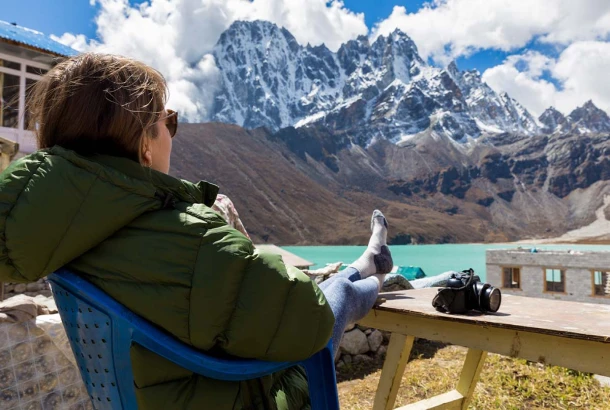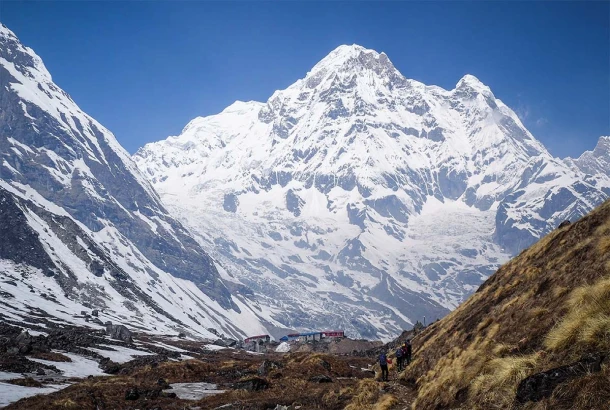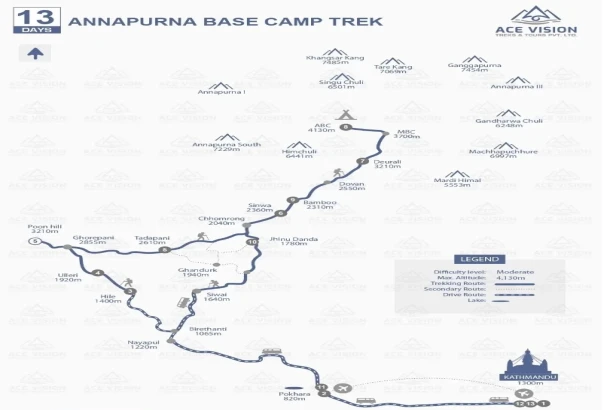Gokyo Lakes Trek Route
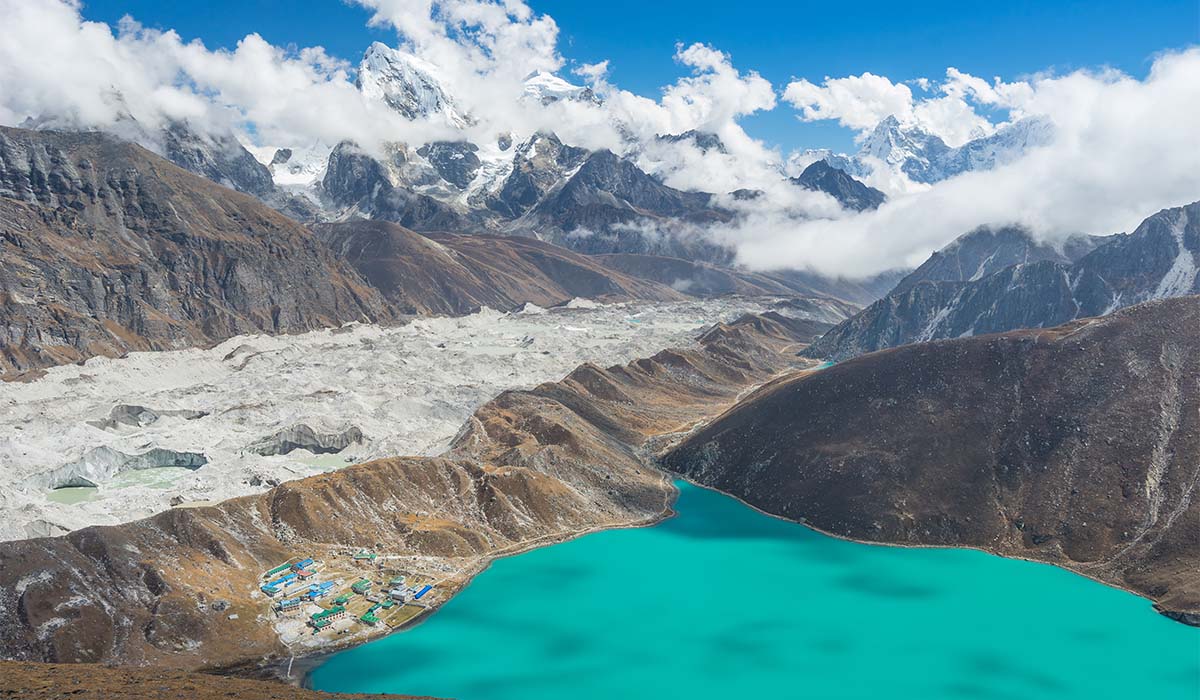
The 13 Day Everest Gokyo Lakes Trek begins on day 1 with your arrival in Kathmandu at 1,300 m. Take this day slow to rest and get ready for the trek ahead. Make sure to catch up with the vibrant energy of this capital city that is full of hustle and bustle, especially around the Thamel area.
After having breakfast, begin your day 2 by taking a flight to Lukla from Kathmandu. Start trekking to Phakding at an altitude of 2,610 m, which might take about 3 to 4 hours. The scenic flight over the Himalayas is truly breathtaking. You can then trek along the Dudh Kosi River, cross various suspension bridges, pass prayer flags, mani walls and quaint villages.
On day 3, begin from Phakding to Namche Bazaar at an altitude of 3,440 meters. It takes around 6 to 7 hours to reach. The walk follows Sagarmatha National Park at Monjo as you pass through pine and rhododendron forests. You can then climb up to the bustling Sherpa town of Namche Bazaar.
Spend day 4 acclimatizing in Namche Bazaar, which is situated at an altitude of 3,440 meters above sea level. Hike into Everest View Hotel or Syangboche Airport by visiting the Sherpa Culture Museum and enjoy views of Kongde Ri and Thamserku peaks.
Begin your day 5 by trekking to Dole at 4,200 meters by walking for about 5 to 6 hours after you’re done having breakfast at your stay. The trail passes through Kyangjuma and Mong La. It then offers majestic views of mountain ranges like Ama Dablam and other local monasteries.
Then on day 6 brings you to Machhermo at 4,470 m in 4 to 5 hours, passing Luza and enjoying panoramic views of Cho Oyu, Cholatse, Taboche and surrounding peaks.
It is on day 7 that you go to Gokyo Valley, which is situated at an altitude of about 4,790 meters after walking for 5 to 6 hours. It passes through ridges, rivers, villages and monasteries. The turquoise color Gokyo Lakes offers a tranquil environment, adding charm to this breathtaking environment.
Spend your best time for Gokyo Ri exploration on day 8 at an elevation of 5,357 meters in 4 to 5 hours. You get expansive views of Everest, Lhotse, Makalu and Cho Oyu. You can visit the Fifth Lake for vibrant Himalayan scenery.
From day 9 to day 12, descend via Machhermo, Dole, Namche Bazaar and Phakding down to Lukla, at 2,840 meters, in 6 to 7 hours. Then on day 12, you can trace the track while enjoying the forests, villages and spectacular landscapes.
Finally, the last day on day 13, you fly back to Kathmandu and then transfer to your hotel or airport. While exploring Kathmandu, if time permits, think over this incredible journey through the Gokyo Lakes region.
Why Does Choosing the Right Time Matter?

Choosing the right time for the Gokyo Trek makes a big difference in how safe, enjoyable and comfortable your journey feels. The best seasons to go are spring (March to May) and autumn (September to November).
During these months, the weather stays stable, the skies are mostly clear and the trails are easy to follow. You can walk without worrying too much about snow, rain or fog. These conditions make every step enjoyable and every view unforgettable.
In spring, the weather feels pleasant and warm during the day, while nights can still be chilly. Rhododendron flowers cover the hillsides in bright colors, adding life to the landscape. As the snow melts, the paths become smoother and the clear skies give you beautiful views of the Himalayas.
However, since spring is popular among trekkers, the trails can get a bit crowded and you might experience light rain at times.
In autumn, the air turns crisp and fresh after the monsoon rains. The days are sunny and dry, perfect for walking and taking photos. The views of the snowy peaks look extra sharp and clear. Although early September may still bring some rain, the rest of the season offers the best visibility of the year.
On the other hand, monsoon and winter treks are tougher. Rain, mud, fog and snow can make the trails slippery and unsafe. So, choosing spring or autumn truly gives you the best experience at Gokyo.
Seasonal Overview of the Gokyo Trek

Spring (March to May)
Spring is considered one of the best time for Gokyo Valley trek. The weather usually remains mild and comfortable, offering warm days and cool nights. Rhododendrons and other wildflowers bloom alongside the trail, painting colors on hillside slopes.
Most of the time, the skies are clear, providing dramatic views of Everest and its satellite peaks. However, since this is one of the best seasons for trekking, you are likely to see more trekkers along the route.
Autumn (September to November)
Another favorable time for the Gokyo Trek is autumn. After the monsoon rains, the air becomes crisp and clean and the weather remains dry and stable. The mountains look amazingly sharp against the bright blue sky.
This season is perfect for photography. The temperatures are comfortable during the daytime and slightly cold during nights. This is also a pretty peaceful trekking time, as there are fewer chances of any weather threats.
Summer/Monsoon (June to August)
Heavy rainfall is common during the monsoon season, particularly at lower altitudes. The trails are often muddy and slippery and leeches can be a nuisance in forested areas. Clouds and fog frequently obscure mountain views. However, while the trails are somewhat quieter, the conditions make the trek more arduous.
Winter (December to February)
It brings cold temperatures and heavy snowfall, particularly in higher altitudes. During this time, some lodges close down, while the high passes are generally blocked by snow. However, for those ready for the cold, winter offers tranquil trails and crystal clear blue skies.
How Difficult is the Gokyo Trek?

The difficulty level of the Gokyo trek can vary a lot depending on the season. You can choose to trek. Spring is one of the easiest seasons in terms of trail conditions. The weather is mild, days are longer and snow has mostly melted from higher paths, making walking easier. Trails are firm, with vibrant rhododendron blooms adding an incentive to every step.
Another appropriate season is autumn, during which the weather is stable, the skies are clear and the trails are dry. Cool air reduces exhaustion during treks and one can get superb views of the Himalayan peaks.
Both seasons, spring and autumn come up with the most comfortable trekking conditions in the region and have fewer complications. Due to this, the overall grade of trekking becomes moderate for the average trekker possessing basic fitness.
The monsoon or summer seasons are more physically demanding due to slippery trails, leeches, heavy rainfall and sometimes clouds can cover the entire visibility. The trek in this season should be done with caution and flexibility, as some routes may be temporarily unsafe.
Overall, the Gokyo Trek is considered to be a moderate trek. Spring and autumn seasons are the easiest and safest seasons. While winter and the monsoon add to physical difficulties and logistical challenges.
How’s the Wildlife and Flora Across the Seasons of Gokyo Valley?
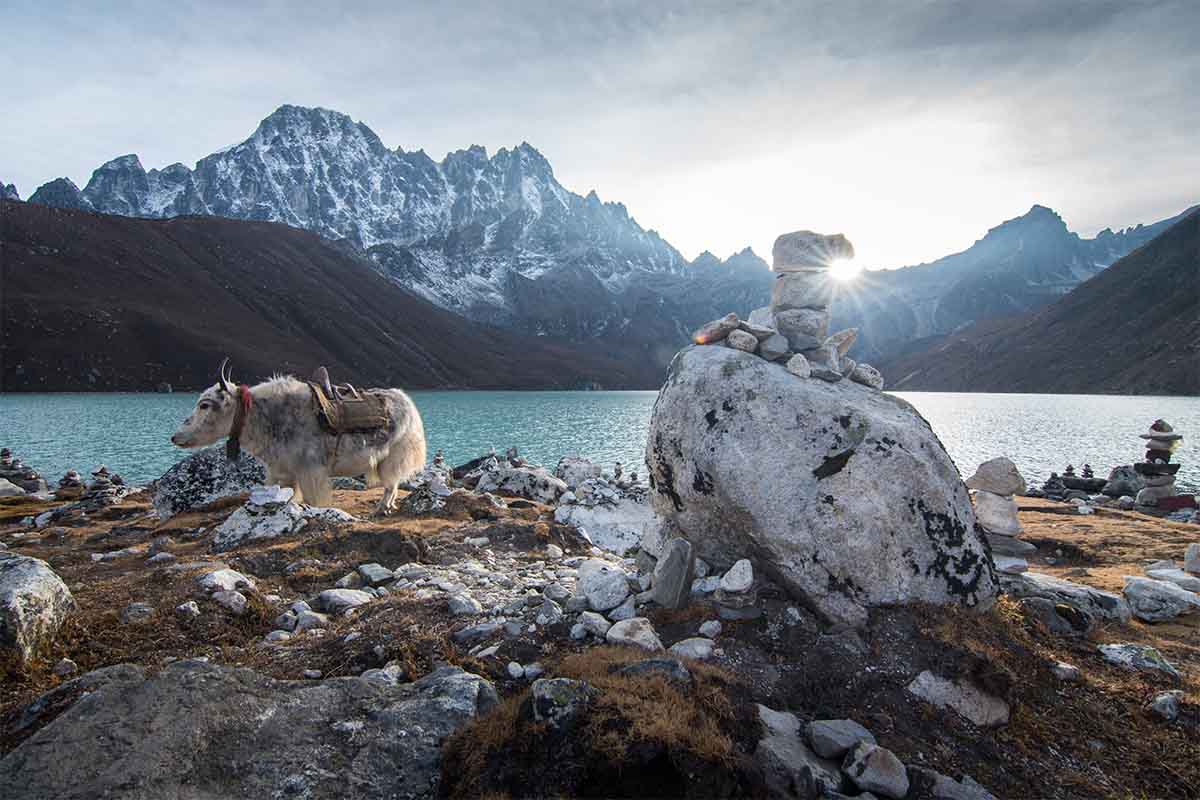
The Gokyo region features a refreshing variation of wildlife and mountain flora that turn beautifully with the seasons. During spring, walking through the lower forests shows bright rhododendrons, fresh pine growth and wildflowers in bloom along the trail.
The warmer months also bring more bird activity, so you may spot the Himalayan monals, snow pigeons or even the shy musk deer in some of the quieter areas.
During autumn, the landscape changes into rich shades of golden color. Forests start to appear cleaner after monsoon rains and clear blue skies make it easier to experience animals grazing along the open slopes. Gradually, wildflowers begin to fade, but this season still feels alive since the valleys remain dry and tranquil.
With winter beginning, it makes the surroundings quite peaceful. Higher sections are fully covered in snow. Most of the animals migrate towards lower to warmer areas where you can still find footprints of blue sheep or hear sounds of higher altitude birds. The plants are in a dormant phase, resulting in a peaceful trail.
Summer and the monsoon season can make the landscape feel lush and green, fully covered in greenery. New plants sprout everywhere and wildlife is more active in the lower valley, although frequent rain can limit sightings higher up.
Generally, spring and autumn are the clearest of seasons with dynamic views, vibrant flora and good chances of viewing wildlife while trekking to Gokyo.
Cultural Festivals & Local Experiences on Gokyo Trail
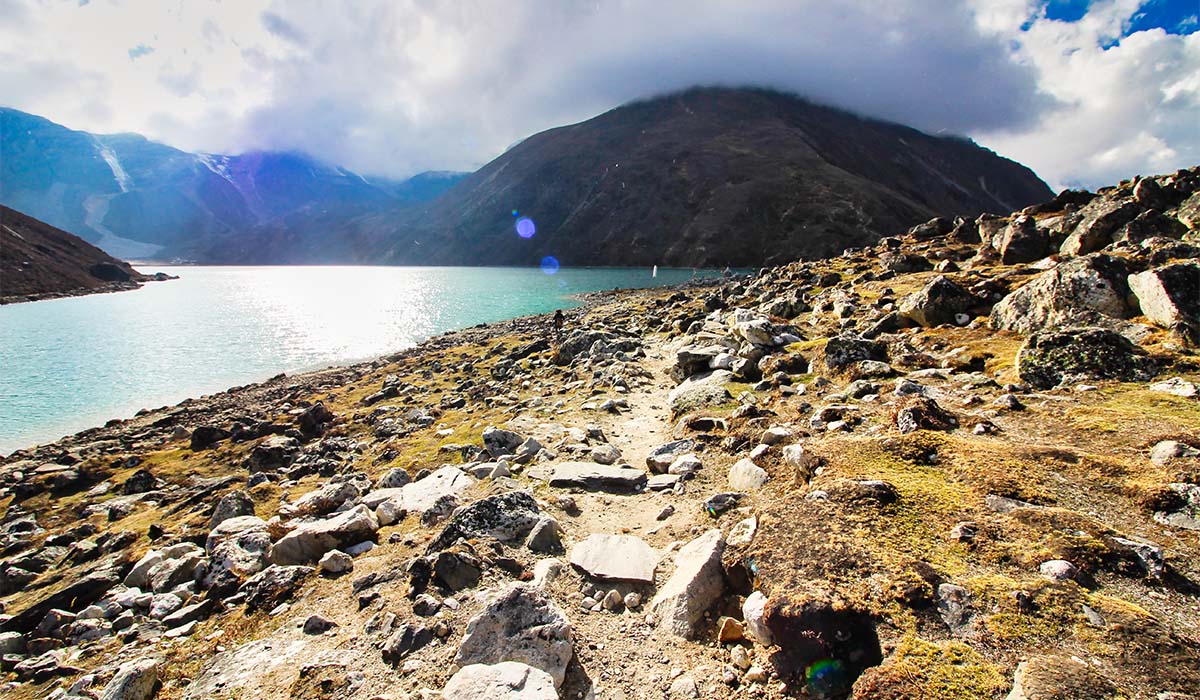
The weather conditions greatly determine the amount of enjoyment and safety you can feel on your Gokyo trek. Scheduling your trek based on he season can help you manage various aspects of this journey.
Spring and autumn seasons are the peak timing that remain the most reliable months. During this time, the days stay clear, the temperatures feel comfortable and the mountain views appear steadily sharp. These seasons also bring fewer weather surprises by helping you move from one village to the next with confidence.
The spring season can bring a gradual warming of the air, melting the snow on higher trails. It can make the route quite easier to follow. As the autumn season arrives with crisp mornings and stable skies following the monsoon, it affords some of the clearest panoramas of the year.
Winter brings generally quiet trails with usually freezing temperatures, icy sections and snowfall that can be quite unpredictable. If you trek during this season, you need to wear warm gear and have some flexible plans in case the conditions change suddenly.
Meanwhile, summer and the monsoon season bring along heavy rainfall, clouds and slippery paths. It might affect flights to Lukla and also reduce visibility along the trail.
You can thus opt for a season that has stable weather conditions, spring or autumn. It will help in ensuring safer walking conditions, consistent views and a smoother overall trekking experience in Gokyo Valley.
How to Plan Your Trek Around the Weather?
Before heading for confirmation about the trek, make sure to properly plan your Gokyo trek around the best weather situation. It can help you enjoy safer trails, better views and a smoother overall experience of this journey.
Spring and autumn are two of the best treks that offer the most stable conditions. Make sure you can walk comfortably under clear blue skies and enjoy long stretches of sunshine. These peak timings can reduce the risk of sudden storms and offer dependable visibility while crossing high sections.
On the contrary, winter brings cold winds, icy paths and occasional snowfall by demanding warmer gear and a flexible everyday plan. Then, summer and monsoon seasons can also have cloudy skies, heavy rainfall and slippery routes. It can slow down your pace and limit the views of the mountain range.
While choosing the best season for your travel, make sure you go with the most predictable weather situation timing. You set yourself up for steady progress, fewer delays and a far more enjoyable journey through the Gokyo Valley.
Tips for Choosing the Best Time for Your Trek
- Choose a season that matches your comfort level, whether you prefer warmer days with blooming scenery or cooler air with clear mountain views.
- Pick peak seasons like spring or autumn if you want the most stable weather, steady visibility and comfortable walking conditions.
- Consider the winter season in case you enjoy quieter trails and can handle freezing temperatures with proper gear and can be flexible with plans.
- For the best experience, avoid the monsoon months if you want dry paths, clear blue skies and a reliable experience throughout the journey.
- Check the Lukla flight updates as a confirmation in advance, as weather can often affect departure and arrival times.
- Match the season with your fitness level, clothing and expectations to enjoy each day of the Gokyo trek confidently.
Why Choose Ace Vision Treks?
You may wonder why Ace Vision Treks for your travel. It is our belief in Ace Vision Treks that we take deep pride in ourselves in offering personal, reliable trekking experiences deeply connected to the mountains we call home.
With years of guiding across Nepal's most iconic regions, we know what it takes to make travelers feel safe, supported and inspired. From the moment you contact us, we handle details with care, from flights to permits, accommodations and every logistical step. So that you could give a full concentration on what's more important in the journey ahead.
Moreover, your safety is our major concern from the very beginning to the end of this journey. We carefully create a personalized itinerary that is based on your requirements. Make sure to prepare well in advance for any weather changes, as well as select guides with deep knowledge of trails.
It means every day, you can move forward with confidence, knowing that there’s a team that has your back. Stay close, communicate clearly and remain agile in shifting situations.
We frequently hear from our clients just how much they appreciate our friendly approach and commitment to making every trip smooth and meaningful.
Believe in giving back, so we support local communities and promote responsible, culturally respectful travel. Altogether, we work hard to create experiences that stay with you long after the trek ends and we are always honored to share the beauty of Nepal with you.
What Accommodation Options Are Available?

Accommodations along the Gokyo Trek will be mostly in teahouses or lodges. It offers a simple and comfortable experience for trekkers with basic twin or dormitory rooms, with a bed, blanket and pillow available in these establishments.
Accommodations become more modest as you go higher, but the warmth of a wood-burning stove or heater makes you comfortable after a long day on the trail.
Meals in tea houses usually include local dishes such as Dal Bhat, noodles, soups and fried rice, besides snacks and hot drinks. Prices for these rise gradually with an increase in altitude, so it is wise to budget accordingly.
The peak seasons are spring and autumn, when more trekkers come in, so booking or having your guide book the rooms would be helpful. During other seasons, such as winter or monsoon, some of the lodges remain shut, so flexibility will be required.
Staying in tea houses also gives an opportunity to meet fellow trekkers, enjoy cultural exchanges with the local Sherpa families and immerse oneself in the serene Himalayan environment. These stops are not only for rest but also act as a connecting medium to bond with the trail's culture and natural beauty.
What to Pack for the Gokyo Trek?
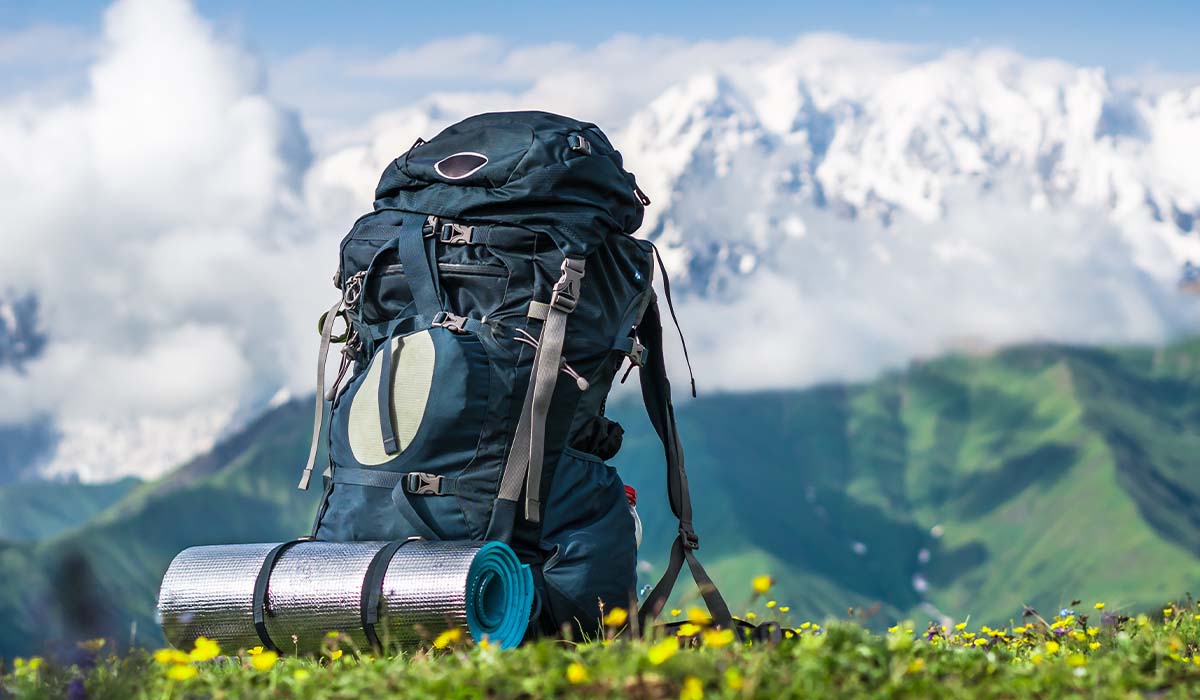
Clothing
- Trekking pants
- Moisture-wicking shirts (short and long-sleeve)
- Thermal base layers (top and bottom)
- Fleece jacket or insulated mid-layer
- Down jacket for higher altitudes
- Warm hat and balaclava or scarf
- Gloves (light and insulated)
- Wool or thermal socks
- Rain jacket or poncho
- Quickly drying shorts and shirts for lower elevations (optional)
Footwear
- Sturdy trekking boots with ankle support
- Comfortable shoes or sandals for evenings
- Gaiters (for snow, mud or dust)
- Crampons or microspikes (for icy trails in winter)
Accessories
- Trekking poles
- Sunglasses with UV protection
- Headlamp or flashlight with spare batteries
- Sun hat or cap
- Backpack rain cover
- Water bottles or hydration system
Sleeping and Camping Gear
- Warm sleeping bag (rated for sub-zero temperatures if trekking in winter)
- Lightweight travel sheet or liner (optional)
Health and Personal Care
- Sunscreen and lip balm with SPF
- Personal toiletries (toothbrush, toothpaste, wet wipes)
- Hand sanitizer
- First-aid kit (including altitude sickness medication)
- Insect repellent
Documents and Miscellaneous
- Passport and visa
- Trekking permits (Sagarmatha National Park permit)
- Travel insurance details
- Camera or smartphone
- Power bank and chargers
Why Pick the Perfect Time for the Best Time to Trek Gokyo Lakes?
Picking the perfect time for the Gokyo Lakes Trek makes it safer, more comfortable and truly memorable.
If we plan the trek around the stable seasons, clear skies with crisp mountain views come along, trails are easier to walk. The walk through higher altitude paths is confidently done while giving full attention to the surrounding breathtaking landscapes.
Spring and autumn are the most rewarding seasons. Days are warm in spring, but nights are cool; rhododendrons and wildflowers bloom along the route. With the melting snow, the higher pathways become visible and clear skies offer the opportunity to glimpse Everest, Lhotse, Makalu and Cho Oyu.
Autumn will bring crisp air and dry trails, with sharp visibility and stable conditions for walking and photography, following the monsoon. These seasons also allow us to enjoy local Sherpa villages, monasteries and cultural encounters without the challenges of extreme weather.
By contrast, winter brings icy paths, cold winds and occasional snowfall, requiring extra gear and careful pacing. The monsoon season brings heavy rains, slippery trails and limited visibility by making the trek at once more difficult and less predictable.
Thus, timing will provide ultimate safety, comfort and scenic beauty. In that way, every step of the Gokyo Lakes Trek. It will be more enjoyable, every view mor












